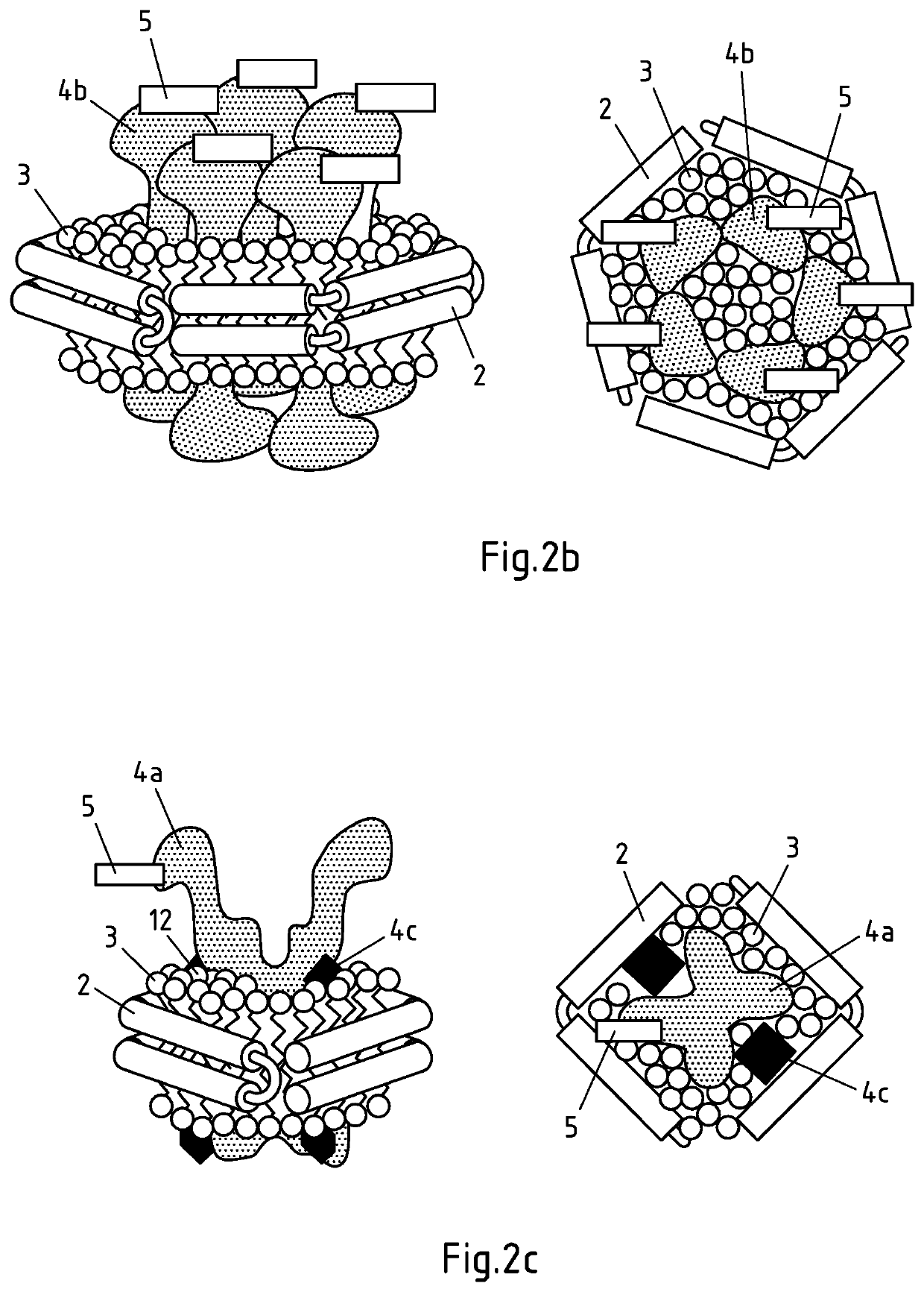Production of salipro particles
a technology of lipoprotein and salipro, which is applied in the direction of liposomal delivery, macromolecular non-active ingredients, pharmaceuticals, etc., can solve the problems of inconvenient biochemical application and inconvenient use of membrane proteins and other hydrophobic agents. to achieve the effect of cost-effective and cost-effectiv
- Summary
- Abstract
- Description
- Claims
- Application Information
AI Technical Summary
Benefits of technology
Problems solved by technology
Method used
Image
Examples
example 1
[0336]In this example, a large transmembrane transporter (SLC) is used as hydrophobic agent in alternative (II) of the process according to the invention. The lipids and the hydrophobic agent are provided in the form of a crude membrane fraction obtained from SLC-overexpressing HEK293F cells. The SLC transporter contains a Strep II-tag as binding moiety. Anti-Strep-II affinity purification beads, were used as support according to the invention. They contain anti-Strep-II capture moieties that are capable of binding the Strep II-binding moiety comprised in the SLC transporter protein. Addition of Saposin A to the support-bound SLC transporter-containing solubilized membranes allowed formation of SLC-transporter-containing saposin lipid particles that were still attached to the support via the Strep-II tag comprised in the SLC transporter protein. Thus, the assembly of the saposin lipid particles took place entirely on the support and with the endogenous lipids that were derived from ...
example 2
[0362]In this example, a membrane protein is used as hydrophobic agent in alternative (II) of the process according to the invention. The lipids and the hydrophobic agent are provided in the form of intact cells, i.e. human embryonic kidney (HEK) cells, overexpressing the membrane protein. Said HEK cells are only contacted with a detergent without performing a mechanical cell lysis step. The eukaryotic membrane protein contains a FLAG-tag as binding moiety. Anti-FLAG affinity purification beads are used as support according to the invention. They contain anti-FLAG capture moieties that are capable of binding the FLAG-binding moiety comprised in the eukaryotic membrane protein. Addition of Saposin A to the support-bound eukaryotic membrane protein comprised in the detergent-treated membranes allows formation of saposin lipid particles containing the eukaryotic membrane protein. Thus, in this example, the assembly of the saposin lipid particles takes place entirely on the support and ...
example 3
[0381]In this example, the reconstitution of Salipro particles was carried out according to alternative (I) of the process of the invention, i.e. Saposin was immobilized on an affinity support. To this end, Saposin was biotinylated and bound to an avidin affinity bead matrix. Contacting the support-bound Saposin with additional untagged Saposin, lipids and optionally a hydrophobic agent allowed formation of Salipro particles according to the invention. Thus, assembly of the saposin lipid particles took place on the support.
[0382]3a. Preparation of Biotinylated Saposin A
[0383]Saposin A was biotinylated using EZ-Link®NHS-Biotin Reagents (Thermo Fisher, reference 21343) according to the manufacturer's protocol. Quantification of the biotin number per Saposin A was then performed with Quant*Tag Biotin Kit (Vector laboratory, BDK-2000) and showed that 1.1 biotins per Saposin A molecule were present.
[0384]3.b. Binding to Affinity Support and Elution
[0385]Monomeric avidin matrix (Thermo Fi...
PUM
| Property | Measurement | Unit |
|---|---|---|
| diameter | aaaaa | aaaaa |
| diameter | aaaaa | aaaaa |
| diameter | aaaaa | aaaaa |
Abstract
Description
Claims
Application Information
 Login to View More
Login to View More - R&D
- Intellectual Property
- Life Sciences
- Materials
- Tech Scout
- Unparalleled Data Quality
- Higher Quality Content
- 60% Fewer Hallucinations
Browse by: Latest US Patents, China's latest patents, Technical Efficacy Thesaurus, Application Domain, Technology Topic, Popular Technical Reports.
© 2025 PatSnap. All rights reserved.Legal|Privacy policy|Modern Slavery Act Transparency Statement|Sitemap|About US| Contact US: help@patsnap.com



